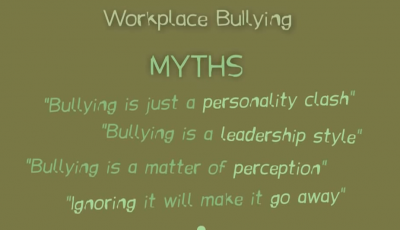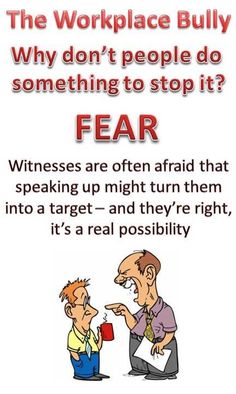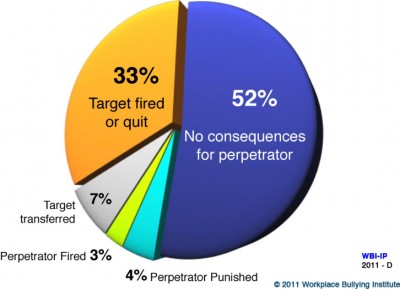 By Hymie Anisman, Dept. of Neuroscience, Carleton University
By Hymie Anisman, Dept. of Neuroscience, Carleton University
In Dante’s Inferno, the ninth circle of hell is reserved for those who engage in treachery
Most of us spend about half of our waking hours at the workplace. For some people work is a positive experience and even acts as a buffer or coping method to deal with life stressors, whereas for others work is a drudge that must be endured. When the workplace becomes a stressor, especially when individuals experience high job demands, but with limited decision latitude (job strain), the occurrence of illnesses, such as heart disease and type 2 diabetes, increases appreciably. These outcomes are exacerbated further when job strain is accompanied by the perception of unfairness or injustice.
Yet another powerful stressor that can be encountered in the workplace is bullying. Although bullying is most frequently discussed in relation to adolescents and school environments, particularly as it has become especially pernicious though attacks coming through social media, it isn’t restricted to adolescent experiences, being much too common in the workplace.
Workplace bullying can take any of multiple forms, and there is little doubt that intentional, prolonged harassment (or violence) coming from a coworker or from a group (mobbing) can lead to a variety of negative neurobiological changes, as well as a range of psychological and physical illnesses. Bullying can be manifested in the form of ostracism, belittling, sarcastic remarks, rudeness, name calling, sexual harassment, scapegoating, threats, violence, overworking an employee, or by ignoring or marginalizing them. Even one of these stressful experiences, such as being ostracized by others, gives rise to brain changes that in several respects are reminiscent of those elicited by pain.
 Not unexpectedly, being the victim of frequent bullying may be accompanied by disturbances of the stress hormone, cortisol, and its diurnal profile is reminiscent of that seen among individuals with PTSD or those going through other chronic stressor experiences. Predictably, bullying can tax coping resources and can have cumulative effects and the distress created, like a cancer, can metastasize so that victims may develop symptoms of depression and anxiety, sleep problems, and in some instances post-traumatic stress disorder (PTSD), with symptoms persisting for years.
Not unexpectedly, being the victim of frequent bullying may be accompanied by disturbances of the stress hormone, cortisol, and its diurnal profile is reminiscent of that seen among individuals with PTSD or those going through other chronic stressor experiences. Predictably, bullying can tax coping resources and can have cumulative effects and the distress created, like a cancer, can metastasize so that victims may develop symptoms of depression and anxiety, sleep problems, and in some instances post-traumatic stress disorder (PTSD), with symptoms persisting for years.
It is sometimes assumed that bullying is uncommon in the workplace, after all ‘we’re all adults here’ and lectures by some human resource groups portray bullying as occurring fairly infrequently. In fact, however, the Workplace Bullying Institute reported in 2007 that 13% of workers felt that they were currently being bullied, and 37% reported that they had been bullied at some time in their working career. What makes the problem worse is that of these individuals only 60% had informed their employers (the remainder indicated that it was pointless to do so), and of that number, two thirds reported the issue was not resolved.
It seems that the bully is an equal-opportunity harasser, and might appear in any type of organization. It might be government organizations, charitable foundations, large corporations or small companies, and even universities.
 It’s especially unfortunate when the bullying emanates from a boss (manager). There’s hardly anyone who hasn’t heard about the boss who is egotistical, demanding, criticizes others for no reason other than self-aggrandizement, who makes a habit or game of humiliating them publicly, and who is described as “not brooking fools lightly” (as if this were a positive attribute). In this group are ‘victim bullies’ who have little in the way of social skills and have themselves previously experienced being bullied or marginalized. This type of bully is relatively easy to spot as they typically exhibit high levels of anger and hostility, and have deficient social skills, problems with emotional regulation, and internalizing disorders, such as depression. In their frustration they take their problems out on staff, perceiving others to be working against them, and because of their own insecurities they react to imaginary threats. Then there are the ‘proactive bullies’, who have positive social skills, but tend to display abusive behavior that is goal-oriented, enabling the them to take credit for the work of others, and whose behavior ultimately benefits them with greater power, privileges, or rewards. This bully can’t bear not being the hero and so is not pleased when others succeed. If anyone challenges this type of bully-boss, they can count on a short tenure in the organization. When the features of the different types of bullies come together in a single individual, then the outcomes are still more ferocious.
It’s especially unfortunate when the bullying emanates from a boss (manager). There’s hardly anyone who hasn’t heard about the boss who is egotistical, demanding, criticizes others for no reason other than self-aggrandizement, who makes a habit or game of humiliating them publicly, and who is described as “not brooking fools lightly” (as if this were a positive attribute). In this group are ‘victim bullies’ who have little in the way of social skills and have themselves previously experienced being bullied or marginalized. This type of bully is relatively easy to spot as they typically exhibit high levels of anger and hostility, and have deficient social skills, problems with emotional regulation, and internalizing disorders, such as depression. In their frustration they take their problems out on staff, perceiving others to be working against them, and because of their own insecurities they react to imaginary threats. Then there are the ‘proactive bullies’, who have positive social skills, but tend to display abusive behavior that is goal-oriented, enabling the them to take credit for the work of others, and whose behavior ultimately benefits them with greater power, privileges, or rewards. This bully can’t bear not being the hero and so is not pleased when others succeed. If anyone challenges this type of bully-boss, they can count on a short tenure in the organization. When the features of the different types of bullies come together in a single individual, then the outcomes are still more ferocious.
There are any number of factors that determine why bully bosses (or bully professors) behave the way they do. Bullying might be a means to maintain power and control over others. Alternatively, as described more than six decades ago, experiences of frustration might breed anger and aggression which is misdirected at those not in a position to fight back. The frustration and ensuing ruthless behavior might develop as a result of excessive job demands (workload and role conflict) and job-related resources that were unavailable (ultimate decision authority, salary/promotion prospects), coupled with a self-perceived incompetence that can be covered over by aggressive behaviors.
 Although it isn’t my intent to describe the multiple factors that could potentially create the bully, I can hardly resist making a couple of comments. There was a move toward explaining this pathology on the basis of dysfunctions within particular brain regions, and there have even been suggestions that these individuals shouldn’t be blamed for their sickness! Regardless, it’s hard to feel sorry for a psychopathic boss who derives satisfaction from humiliating employees. Robert Hare, a major researcher in psychopathy has indicted that 1% of individuals could be categorized as being a psychopath. Although movies and some novels would have us believe that the psychopath is an evil person who engages in criminal acts (like Dr Lecter in Silence of the Lambs, or Patrick Bateman in American Psycho), psychopaths are present across the spectrum of white collar professions. According to Hare, psychopathy ought to be distinguished from insanity. Psychopaths know and understand what they’re doing, but experience an “emotional deafness”, being unable to have any empathy for others. They focus on their own interests and perceive others simply as pawns or suckers that can be preyed upon, and when they encounter pushback, even if it’s imaginary, they claim that they’re the victim.
Although it isn’t my intent to describe the multiple factors that could potentially create the bully, I can hardly resist making a couple of comments. There was a move toward explaining this pathology on the basis of dysfunctions within particular brain regions, and there have even been suggestions that these individuals shouldn’t be blamed for their sickness! Regardless, it’s hard to feel sorry for a psychopathic boss who derives satisfaction from humiliating employees. Robert Hare, a major researcher in psychopathy has indicted that 1% of individuals could be categorized as being a psychopath. Although movies and some novels would have us believe that the psychopath is an evil person who engages in criminal acts (like Dr Lecter in Silence of the Lambs, or Patrick Bateman in American Psycho), psychopaths are present across the spectrum of white collar professions. According to Hare, psychopathy ought to be distinguished from insanity. Psychopaths know and understand what they’re doing, but experience an “emotional deafness”, being unable to have any empathy for others. They focus on their own interests and perceive others simply as pawns or suckers that can be preyed upon, and when they encounter pushback, even if it’s imaginary, they claim that they’re the victim.
 As psychopaths typically have above average intelligence, their ruthlessness and fixation on personal power increase the odds that they will make advances in organizations (corporate, political, university). In their 2007 book ‘Snakes in Suits; When Psychopaths go to Work’, Babiak and Hare provided an extensive description of the corporate psychopath, the different strategies they endorse to get what they want (manipulation, bullying, anger, emotional outbursts, among other manipulative behaviors) and the extent to which they will go to reach the goals and needs on their agenda. It has been estimated by Boddy and his associates (2010) that although they might make up only 1% of the workforce, psychopaths account for more than 26% of workplace bullying. Given these numbers, one might wonder why bullies aren’t gotten rid of by their bosses? Boddy surmised that the corporate culture has enabled the destructive bullying behaviors by these individuals, as their corporations look to profits generated by psychopaths, and thus take little action to discourage malevolent behaviors. In essence, the psychopathic bully might be convenient to have around. Alternatively, because psychopathic bullies punch down and suck up, their bosses might not recognize them as being what they actually are.
As psychopaths typically have above average intelligence, their ruthlessness and fixation on personal power increase the odds that they will make advances in organizations (corporate, political, university). In their 2007 book ‘Snakes in Suits; When Psychopaths go to Work’, Babiak and Hare provided an extensive description of the corporate psychopath, the different strategies they endorse to get what they want (manipulation, bullying, anger, emotional outbursts, among other manipulative behaviors) and the extent to which they will go to reach the goals and needs on their agenda. It has been estimated by Boddy and his associates (2010) that although they might make up only 1% of the workforce, psychopaths account for more than 26% of workplace bullying. Given these numbers, one might wonder why bullies aren’t gotten rid of by their bosses? Boddy surmised that the corporate culture has enabled the destructive bullying behaviors by these individuals, as their corporations look to profits generated by psychopaths, and thus take little action to discourage malevolent behaviors. In essence, the psychopathic bully might be convenient to have around. Alternatively, because psychopathic bullies punch down and suck up, their bosses might not recognize them as being what they actually are.
Bullying is obviously a serious problem for any organization, and it requires a good leader to manage such issues. This is especially important given the effects of bullying on workplace productivity, creativity, and loyalty, sick leaves being taken, absenteeism as well as disengagement from the organization. In this regard, ill effects are not only experienced by the victim of bullying, but also by witnesses to the bullying. This could stem from empathetic reactions, or perhaps from the guilt or despair created by not being able to intervene, or the fear of the same thing happening to them. It may be particularly relevant that witnesses to others being bullied increases their intention to leave the organization.
 When a leader sits does nothing in the face of others being persecuted, they’re essentially taking the side of the oppressor. Unfortunately, this occurs all too frequently. Often, despite the bullying by low level managers, more senior managers might simply ignore obvious problems, even when complaints have been made. Perhaps they’ll mouth patronizing statements about there being two sides to every story. However, some senior managers rarely speak with the rank and file and might simply hear the story from the side of the low level manager. In some instances, the senior manager hopes the problem will dissipate on its own over time, or they may engage in a series of exercises that don’t fix the problem, but instead inflame an already bad situation. Unfortunately, fires don’t go out until all the fuel has been consumed.
When a leader sits does nothing in the face of others being persecuted, they’re essentially taking the side of the oppressor. Unfortunately, this occurs all too frequently. Often, despite the bullying by low level managers, more senior managers might simply ignore obvious problems, even when complaints have been made. Perhaps they’ll mouth patronizing statements about there being two sides to every story. However, some senior managers rarely speak with the rank and file and might simply hear the story from the side of the low level manager. In some instances, the senior manager hopes the problem will dissipate on its own over time, or they may engage in a series of exercises that don’t fix the problem, but instead inflame an already bad situation. Unfortunately, fires don’t go out until all the fuel has been consumed.
Hymie Anisman has recently authored two books providing an evidence-based approach to understanding the role of stress on human health, and identifying characteristics and behaviours that render people more vulnerable or resilient. Both are available at Amazon.ca

